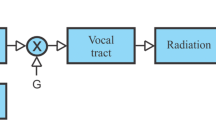Abstract
We present a simple index, extended harmonic distortion (k d ), to represent the degree of system nonlinearity under sparse pseudorandom noise inputs (SPRN). The frequencies in a SPRN waveform are neither harmonics nor sums or differences of the other component frequencies. Expressed by percentage, thek d is the square root of the ratio of output power at non-input frequencies to the total output power. We evoke three simple corrections to recover the truek d under imperfect SPRN inputs. Simulations on two block-structured nonlinear models (Wiener and Hammerstein) demonstrate the necessity and effectiveness of these corrections especially for the Wiener-type nonlinearity. By applyingk d to pressure-flow data of dog lungs, we found that the nonlinear harmonic interactions from a lung arise primarily from its tissues most likely the processes governing the tissue stiffness. This nonlinearity, assessed fromk d , is stronger at higher tidal volumes and enhanced (but to a lesser degree) during bronchoconstriction. We conclude that since thek d approach avoids the necessity for multiple-input measurements and lengthy data records, it may be useful for tracking the dynamic variations in nonlinearities of a physiological system.
Similar content being viewed by others
References
Barnas, G. M., D. N. Campbell, C. F. Mackenzie, J. E. Mendham, B. G. Fahy, C. J. Runcie, and G. E. Mendham. Lung, chest wall, and total respiratory system resistance and elastance in the normal range of breathing.Am. Rev. Respir. Dis. 143:240–244, 1991.
Barnas, G. M., D. Stamenović, and K. R. Lutchen. Lung and chest wall impedances in the dog in normal range of breathing: effects of pulmonary edema.J. Appl. Physiol. 73:1040–1046, 1992.
Davis, K. A., and K. R. Lutchen. Respiratory impedance spectral estimation for digitally created random noise.Ann. Biomed. Eng. 9:179–195, 1991.
Fredberg, J. J., and D. Stamenović. On the imperfect elasticity of lung tissue.J. Appl. Physiol. 67(6):2408–2419, 1989.
Fung, Y. C.Biomechanics: Mechanical Properties of Living Tissues. New York: Springer-Verlag, 1981, 433 pp.
Grant, B. J. B., and L. J. Paradowski. Characterization of pulmonary arterial input impedance with lumped parameter models.Am. J. Physiol. 252 (Heart Circ. Physiol. 21): H585-H593, 1987.
Gunst, S. J., D. O. Warner, T. A. Wilson, and R. E. Hyatt. Parenchymal interdependence and airway response to methacholine in excised dog lobs.J. Appl. Physiol. 65: 2409–2497, 1988.
Hantos, Z., Á. Adamicza, E. Govaerts, and B. Daróczy. Mechanical impedance of the lungs and chest wall in the cat.J. Appl. Physiol. 73:427–433, 1992.
Hantos, Z., B. Daróczy, B. Suki, G. Galgoczy, and T. Csendes. Forced oscillatory impedance of the respiratory system at low frequencies.J. Appl. Physiol. 60:123–132, 1986.
Ingenito, E. P., L. Mark, and B. Davison. Effects of acute lung injury on dynamic tissue properties.J. Appl. Physiol. 77(6):2689–2697, 1994.
Ludwig, M. S., F. M. Robatto, S. Simard, D. Stamenović, and J. J. Fredberg. Lung tissue resistance during contractile stimulation: structural damping decomposition.J. Appl. Physiol. 72(4):1332–1337, 1992.
Lutchen, K. R., and A. C. Jackson. Effects of tidal volume and methacholine on low frequency total respiratory impedance in dogs.J. Appl. Physiol. 68:2128–2138, 1990.
Lutchen, K. R., B. Suki, Q. Zhang, F. Peták, B. Daróczy, and Z. Hantos. Airway and tissue mechanics during physiological breathing and bronchoconstriction in dogs.J. Appl. Physiol. 77(1):373–385, 1994.
Lutchen, K. R., K. Yang, D. W. Kaczka, and B. Suki. Optimal ventilator waveform for estimating low frequency mechanical impedance in healthy and diseased subjects.J. Appl. Physiol. 75(1):478–488, 1993.
Nagase, T., A. Moretto, and M. S. Ludwig. Airway and tissue behavior during induced constriction in rats: intravenous vs. aerosol administration.J. Appl. Physiol. 76(2): 830–838, 1994.
Navajas, D., S. Mijailovich, G. M. Glass, D. Stamenović, and J. J. Fredberg. Dynamic response of the isolated passive rat diaphragm strip.J. Appl. Physiol. 73(6):2681–2692, 1992.
Otis, A. B., C. B. McKerrow, R. A. Bartlett, J. Mead, M. B. McIlroy, N. J. Silverstone, and E. P. Radford, Jr. Mechanical factors in distribution of pulmonary ventilation.J. Appl. Physiol. 8:427–443, 1956.
Radke, N. F., C. L. Lucas, B. R. Wilcox, and B. A. Keagy. Infant pulmonary vascular model based on the pulmonary input impedance spectrum.Ann. Biomed. Eng. 13: 531–550, 1985.
Romero, P. V., F. M. Robatto, S. Simard, and M. S. Ludwig. Lung tissue behavior during methacholine challenge in rabbits in vivo.J. Appl. Physiol. 73(1):207–212, 1992.
Schetzen, M.The Volterra and Wiener Theories of Nonlinear Systems. Malabar, Florida: Robert E. Krieger Publishing Company, 1989, 573 pp.
Stamenović, D., K. R. Lutchen, and G. M. Barnas. Alternative model of respiratory tissue viscoplasticity.J. Appl. Physiol. 75(3):1062–1069, 1993.
Suki, B., and K. R. Lutchen. Pseudorandom signals to estimate apparent transfer and coherence functions of nonlinear systems: applications to respiratory mechanics.IEEE Trans. Biomed. Eng. 39(11):1142–1151, 1992.
Suki, B., and J. H. T. Bates. A nonlinear viscoelastic model of lung tissue mechanics.J. Appl. Physiol. 71(3): 826–833, 1991.
Suki, B., Z. Hantos, B. Daróczy, G. Alkaysi, and S. Nagy. Nonlinearity and harmonic distortion of dog lungs measured by low-frequency forced oscillations.J. Appl. Physiol. 71(1):69–75, 1991.
Suki, B. Nonlinear phenomena in respiratory mechanical measurement.J. Appl. Physiol. 74(5):2574–2584, 1993.
Suki, B., Q. Zhang, and K. R. Lutchen. Relationship between frequency and amplitude dependence in the lung: a nonlinear block-structured modeling approach.J. Appl. Physiol., in press.
Victor, J. D. Nonlinear systems analysis: comparison of white noise and sum of sinusoids in a biological system.Proc. Natl. Acad. Sci. USA 76(2):996–998, 1979.
Victor, J., and R. Shapley. A method of nonlinear analysis in the frequency domain.Biophys. J. 29:459–484, 1980.
Author information
Authors and Affiliations
Rights and permissions
About this article
Cite this article
Zhang, Q., Suki, B. & Lutchen, K.R. Harmonic distortion from nonlinear systems with broadband inputs: Applications to lung mechanics. Ann Biomed Eng 23, 672–681 (1995). https://doi.org/10.1007/BF02584464
Received:
Revised:
Accepted:
Issue Date:
DOI: https://doi.org/10.1007/BF02584464




